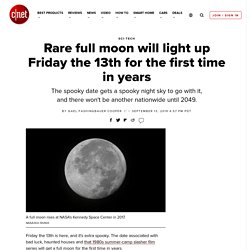

Rare full moon will light up Friday the 13th for the first time in years. Friday the 13th is here, and it's extra spooky.

The date associated with bad luck, haunted houses and that 1980s summer-camp slasher film series will get a full moon for the first time in years. According to the Farmers' Almanac, those living in the Pacific, Central and Mountain time zones will get to gaze on the full moon before midnight on Friday, Sept. 13, but those living in the Eastern time zone will have to fudge a little. Their full moon will happen just after midnight, at 12:33 a.m., pushing it to the much-less-spooky date of Saturday, Sept. 14.
If you miss seeing it Friday night into Saturday, you'll get another chance. NASA says the moon will appear full again Saturday night into Sunday morning. Now playing: Watch this: Our future on the moon: What will the moon look like... Black Holes May Hide Cores of Pure Dark Energy That Keep The Universe Expanding. A fifty-year-old hypothesis predicting the existence of bodies dubbed Generic Objects of Dark Energy (GEODEs) is getting a second look in light of a proposed correction to assumptions we use to model the way our Universe expands.

If this new version of a classic cosmological model is correct, some black holes could hide cores of pure dark energy, pushing our Universe apart at the seams. University of Hawai'i astrophysicist Kevin Croker and mathematician Joel Weiner teamed up to challenge the broadly accepted notion that when it comes to the Universe's growing waistline, its contents are largely irrelevant. Long-Lived Stellar Blast Kindles Hope of a Pair-Instability Supernova. The early universe contained practically no metals whatsoever, as stars hadn’t made them yet.

Primordial stars, the first metallurgists, made the heavy elements that helped create future generations of stars and, eventually, planets. These early stars were, Fields said, effectively the “first seeds of life.” They were also, he added, “one of the first beacons that lit up the universe and ended the dark ages.” They were probably supermassive too, which makes the star that caused SN 2016iet a preview of how they may have looked and behaved.
Quantum Physics Is Fine, Human Bias About Reality Is The Real Problem. By creating two entangled photons from a pre-existing system and separating them by great distances, we can 'teleport' information about the state of one by measuring the state of the other, even from extraordinarily different locations.

Interpretations of quantum physics that demand both locality and realism cannot account for a myriad of observations, but multiple interpretations all appear to be equally good. Melissa Meister, of laser photons through a beam splitter When it comes to understanding the Universe, scientists have traditionally taken two approaches in tandem with one another. On the one hand, we perform experiments and make measurements and observations of what the results are; we obtain a suite of data. On the other hand, we construct theories and models to describe reality, where the predictions of those theories are only as good as the measurements and observations they match up with.
Wikimedia commons users MichaelMaggs and (edited by) Richard Bartz Chad Orzel Dr. Right Again, Einstein! Wobbling Pulsar Confirms General Relativity. Einstein's theory of general relativity has been confirmed once again, this time in the wobbling of a pulsar 25,000 light-years from Earth.

Over the span of 14 years, astronomers observed the spinning neutron star PSR J1906+0746. Their goal? To study the wobble, or precession, of two pulsars as they orbit each other, a rare phenomenon predicted by general relativity. The astronomers, led by Gregory Desvignes from the Max Planck Institute for Radio Astronomy in Bonn, Germany, published their results in the Sept. 6 issue of the journal Science. Their findings could help estimate the number of these so-called binary pulsars in our galaxy and the rate of neutron star mergers, which might produce gravitational waves (also predicted by relativity) that can be observed on Earth. Related: 8 Ways You Can See Einstein’s Theory of Relativity in Real Life Pulsars are rapidly spinning neutron stars that beam jets of charged particles from their magnetic poles. Baffling maths riddle that looks like a pile of worms almost solved. By Benjamin Skuse Illustration by Edmund Harriss, coloured in by Tiffany Arment We almost have a solution to an exceptionally tricky mathematical riddle first posed 82 years ago.

The problem, known as the Collatz conjecture, is easy to state. Start with any positive whole number. If it is even, divide it by two. The sequence can be depicted visually to show sequences of numbers all wiggling their way back to the same spot (see main image). Advertisement As well as being visually arresting, it is intensely difficult to prove true or false. Now mathematician Terence Tao at the University of Califonia, Los Angeles, seems to have almost pulled it off. “Many math problems become easier when one allows a small number of exceptional cases to behave badly and one is willing to settle for controlling almost all cases,” says Tao.
Jeffrey Lagarias from the University of Michigan describes Tao’s work as “the most significant progress on the problem in many years”. Reference: arxiv.org/909.03562.